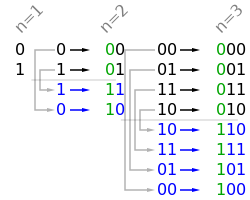Medium!
题目描述:
格雷编码是一个二进制数字系统,在该系统中,两个连续的数值仅有一个位数的差异。
给定一个代表编码总位数的非负整数 n,打印格雷码序列。格雷码序列必须以 0 开头。
例如,给定 n = 2,返回 [0,1,3,2]。其格雷编码是:
00 - 0 01 - 1 11 - 3 10 - 2
说明:
对于给定的 n,其格雷编码的顺序并不唯一。
例如 [0,2,3,1] 也是一个有效的格雷编码顺序。
解题思路:
格雷码是一种循环二进制单位距离码,主要特点是两个相邻数的代码只有一位二进制数不同的编码,格雷码的处理主要是位操作 Bit Operation,LeetCode中关于位操作的题也挺常见,比如 Repeated DNA Sequences 求重复的DNA序列, Single Number 单独的数字, 和 Single Number II 单独的数字之二 等等。三位的格雷码和二进制数如下:
Int Grey Code Binary 0 000 000 1 001 001 2 011 010 3 010 011 4 110 100 5 111 101 6 101 110 7 100 111
其实这道题还有多种解法。首先来看一种最简单的,是用到格雷码和二进制数之间的相互转化,可参见http://www.cnblogs.com/grandyang/p/4315607.html,明白了转换方法后,这道题完全没有难度。
C++解法一:
1 // Binary to grey code 2 class Solution { 3 public: 4 vector<int> grayCode(int n) { 5 vector<int> res; 6 for (int i = 0; i < pow(2,n); ++i) { 7 res.push_back((i >> 1) ^ i); 8 } 9 return res; 10 } 11 };
然后我们来看看其他的解法,参考维基百科上关于格雷码的性质,有一条是说镜面排列(http://zh.wikipedia.org/wiki/%E6%A0%BC%E9%9B%B7%E7%A0%81)的,n位元的格雷码可以从n-1位元的格雷码以上下镜射后加上新位元的方式快速的得到,如下图所示一般。

有了这条性质,我们很容易的写出代码如下。
C++解法二:
1 // Mirror arrangement 2 class Solution { 3 public: 4 vector<int> grayCode(int n) { 5 vector<int> res{0}; 6 for (int i = 0; i < n; ++i) { 7 int size = res.size(); 8 for (int j = size - 1; j >= 0; --j) { 9 res.push_back(res[j] | (1 << i)); 10 } 11 } 12 return res; 13 } 14 };
维基百科上还有一条格雷码的性质是直接排列(http://zh.wikipedia.org/wiki/%E6%A0%BC%E9%9B%B7%E7%A0%81),以二进制为0值的格雷码为第零项,第一项改变最右边的位元,第二项改变右起第一个为1的位元的左边位元,第三、四项方法同第一、二项,如此反复,即可排列出n个位元的格雷码。根据这条性质也可以写出代码,不过相比前面的略微复杂,代码如下:
0 0 0
0 0 1
0 1 1
0 1 0
1 1 0
1 1 1
1 0 1
1 0 0
C++解法三:
1 // Direct arrangement 2 class Solution { 3 public: 4 vector<int> grayCode(int n) { 5 vector<int> res{0}; 6 int len = pow(2, n); 7 for (int i = 1; i < len; ++i) { 8 int pre = res.back(); 9 if (i % 2 == 1) { 10 pre = (pre & (len - 2)) | ((~pre) & 1); 11 } else { 12 int cnt = 1, t = pre; 13 while ((t & 1) != 1) { 14 ++cnt; 15 t >>= 1; 16 } 17 if ((pre & (1 << cnt)) == 0) pre |= (1 << cnt); 18 else pre &= ~(1 << cnt); 19 } 20 res.push_back(pre); 21 } 22 return res; 23 } 24 };
上面三种解法都需要事先了解格雷码及其性质,假如我们之前并没有接触过格雷码,那么我们其实也可以用比较笨的方法来找出结果,比如下面这种方法用到了一个set来保存已经产生的结果,我们从0开始,遍历其二进制每一位,对其取反,然后看其是否在set中出现过,如果没有,我们将其加入set和结果res中,然后再对这个数的每一位进行遍历,以此类推就可以找出所有的格雷码了。
C++解法四:
1 class Solution { 2 public: 3 vector<int> grayCode(int n) { 4 vector<int> res; 5 unordered_set<int> s; 6 helper(n, s, 0, res); 7 return res; 8 } 9 void helper(int n, unordered_set<int>& s, int out, vector<int>& res) { 10 if (!s.count(out)) { 11 s.insert(out); 12 res.push_back(out); 13 } 14 for (int i = 0; i < n; ++i) { 15 int t = out; 16 if ((t & (1 << i)) == 0) t |= (1 << i); 17 else t &= ~(1 << i); 18 if (s.count(t)) continue; 19 helper(n, s, t, res); 20 break; 21 } 22 } 23 };
既然递归方法可以实现,那么就有对应的迭代的写法,当然需要用stack来辅助。
C++解法五:
1 class Solution { 2 public: 3 vector<int> grayCode(int n) { 4 vector<int> res{0}; 5 unordered_set<int> s; 6 stack<int> st; 7 st.push(0); 8 s.insert(0); 9 while (!st.empty()) { 10 int t = st.top(); st.pop(); 11 for (int i = 0; i < n; ++i) { 12 int k = t; 13 if ((k & (1 << i)) == 0) k |= (1 << i); 14 else k &= ~(1 << i); 15 if (s.count(k)) continue; 16 s.insert(k); 17 st.push(k); 18 res.push_back(k); 19 break; 20 } 21 } 22 return res; 23 } 24 };
